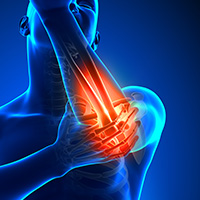Call Today
(410) 650-9804

Osteoarthritis in the elbow is characterized by degeneration of the joint cartilage as a person ages. Injuries to the elbow can damage the cartilage and can develop into arthritis, even years later. Rheumatoid arthritis is an autoimmune disease that causes the joint linings to swell. Rheumatoid arthritis destroys the tissues, cartilage and bone in the elbow.
The most common symptoms or signs of arthritis in the elbow are joint pain and stiffness and swelling.
Arthritis in the elbow is diagnosed through a physical exam by our practitioner. The practitioner may order additional imaging to evaluate the arthritic changes.

Risk factors for elbow osteoarthritis include:

Treatment for arthritis in the elbow depends on the progression of the disease, imaging results and current medical condition.
In early stages, patients can manage the pain with anti-inflammatory medications, physical therapy and modification of activity levels.
As the disease progresses, the patient may benefit from corticosteroid injections, platelet rich plasma (PRP) treatment, or other non-invasive treatments. In the most severe cases, an elbow replacement may be indicated.

There is no complete cure for arthritis in the elbow. It is important to work with the practitioner to manage the symptoms to slow the progression of the disease.
The goal of the treatments is to maximize function in the elbow in order to get as much motion in the joint as possible.
